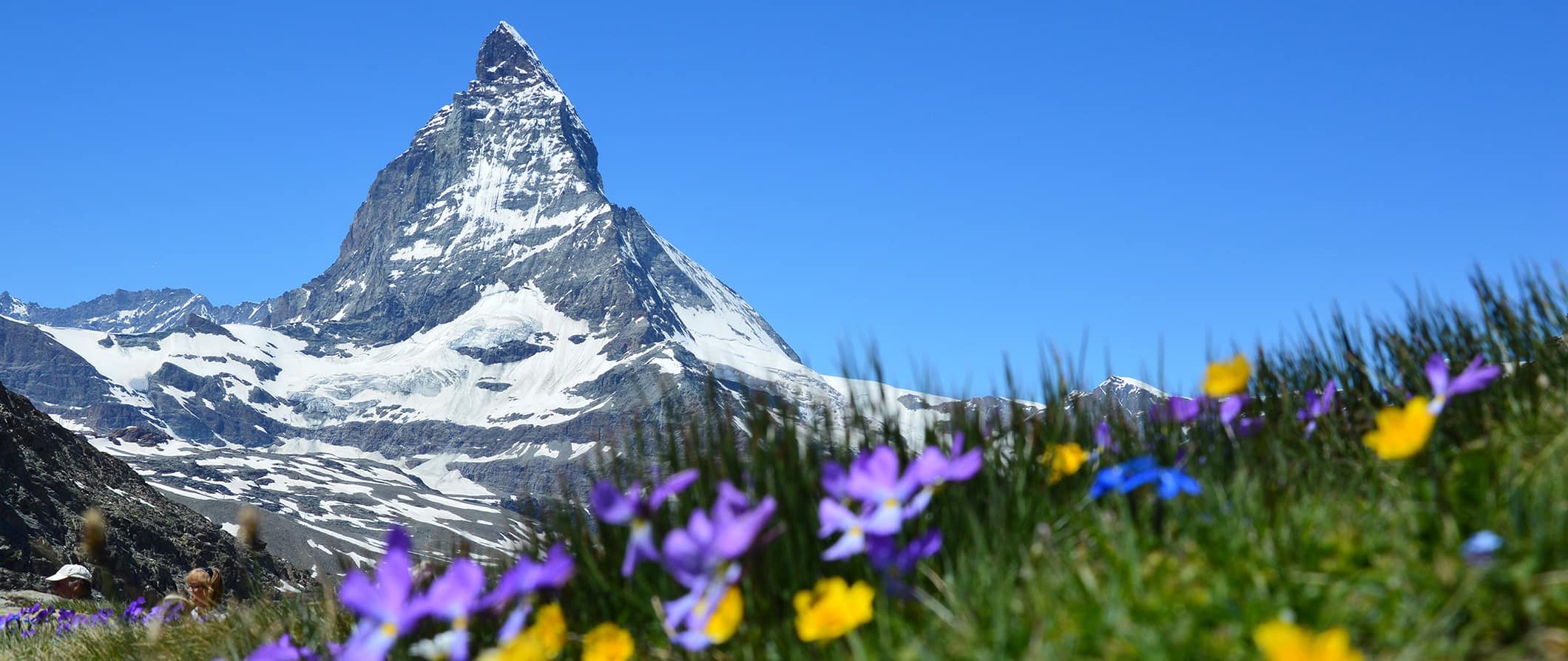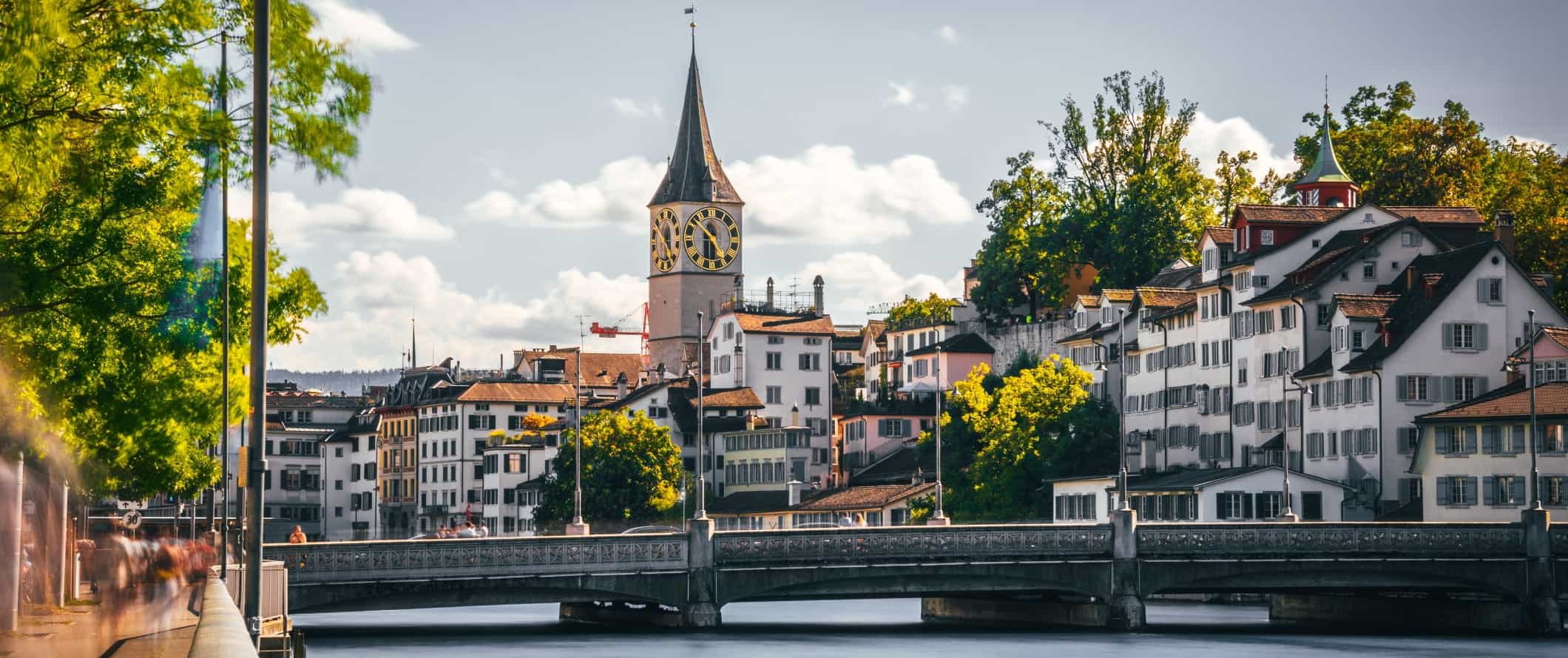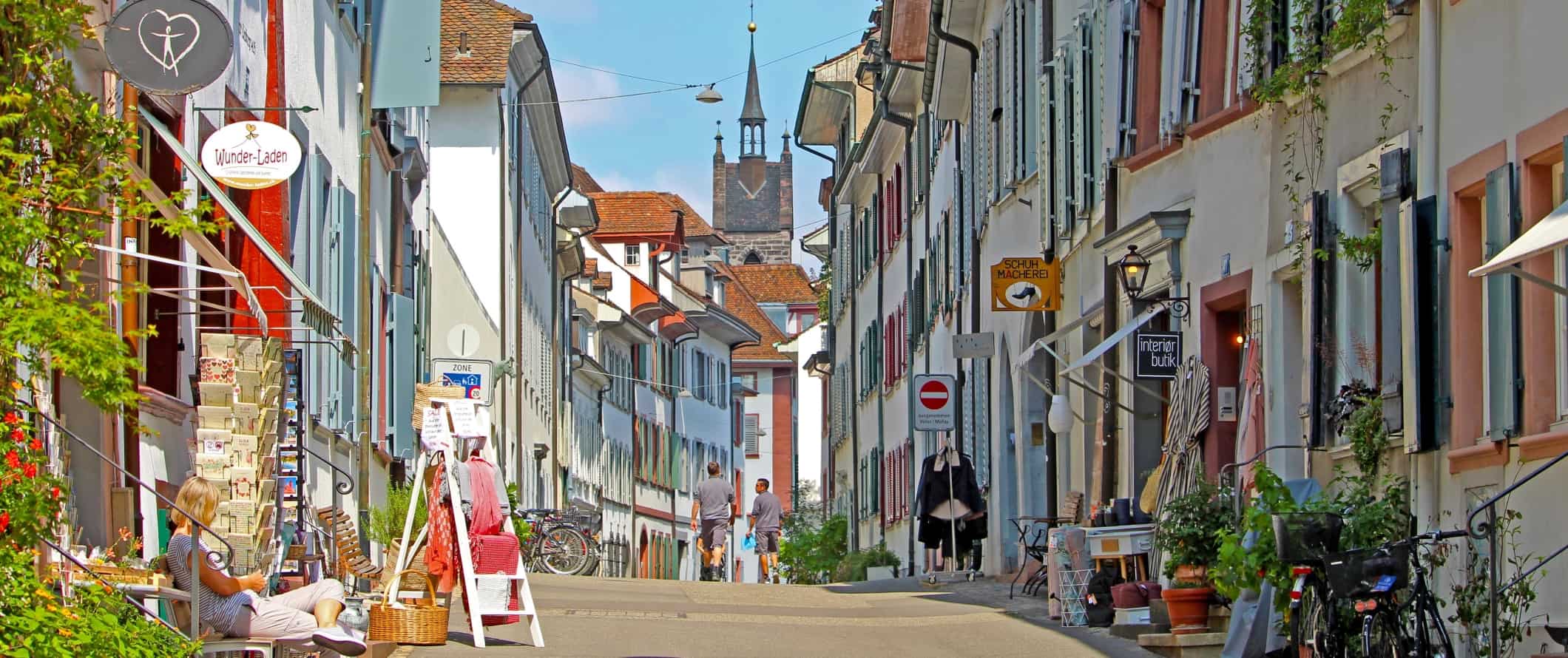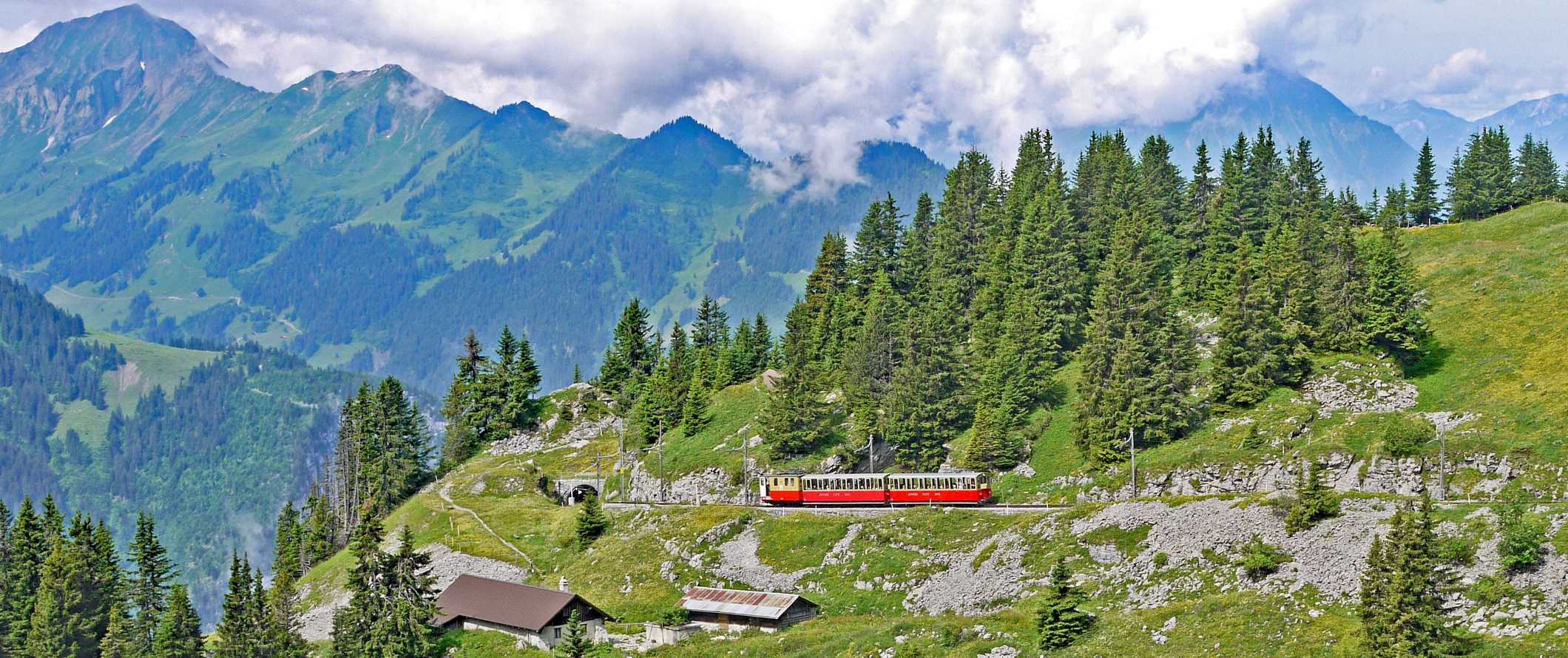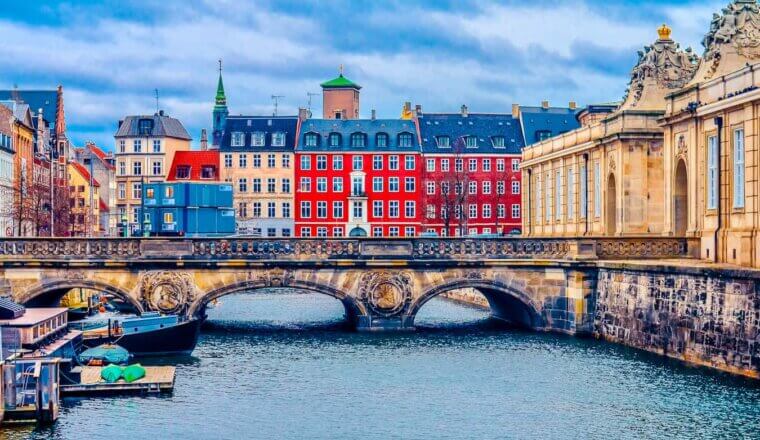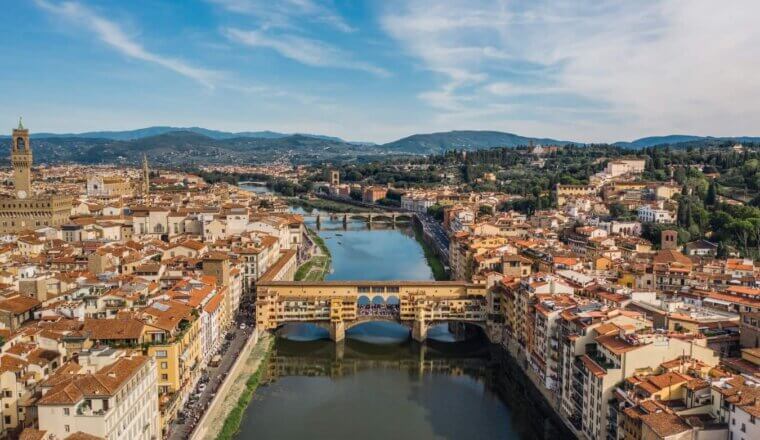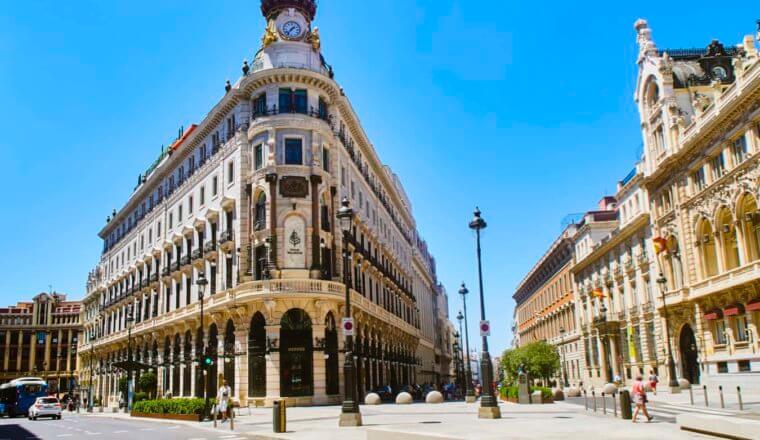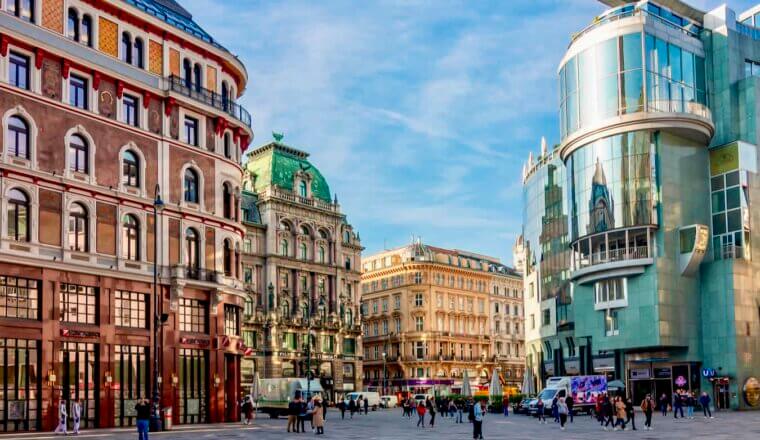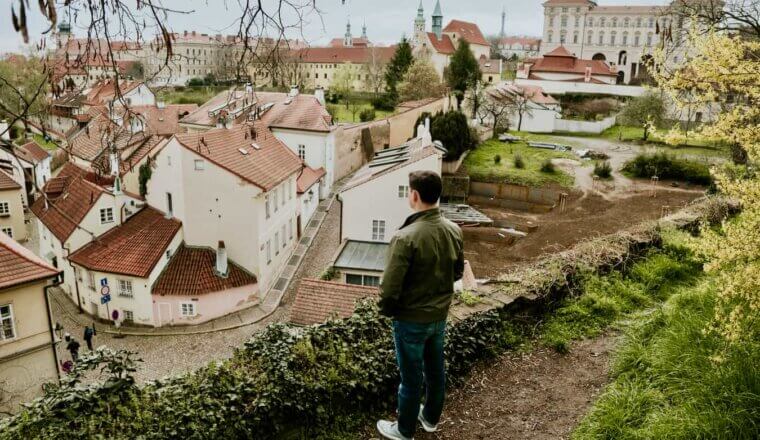As one of the most expensive countries in Europe, Switzerland is often skipped over by budget travelers.
Yet, while it is not a cheap destination, Switzerland is one of the most beautiful places on earth.
This land-locked country is home to shimmering lakes (more than 7,000 of them!), picturesque mountains (hello Alps!), tiny walled medieval towns, historic cities, soaring peaks, endless green fields you want to run through, delicious chocolate and cheese, incredible beer, and friendly, welcoming people. It’s known for ski resorts, hiking trails, its neutral foreign policy stance, being a banking and finance center, and making Swiss watches.
Everything runs on time here, the country is safe, and everyone is super nice. I loved my time traveling around Switzerland and the country rocks no matter what time of the year you visit.
This travel guide to Switzerland to help you plan your trip, save money, and ensure you make the most out of your time here.
Table of Contents
Click Here for City Guides
Top 5 Things to See and Do in Switzerland
1. Tour the capital
Bern has an amazing historic center. This part of town is filled with medieval clocktowers, cobblestone streets, churches, and well-preserved sandstone homes. Be sure to walk the River Aare way, visit the History Museum and the Einstein Museum, and check out the bears at the Bear Park!
2. Ski the Matterhorn
The Matterhorn’s sharp angular peak is one of Switzerland’s most iconic attractions. You have to take a train or bus into the Zermatt area (the closest town to the mountain) as cars aren’t allowed. If you miss ski season, come hike the mountain in the summer. You can take the world’s highest cable car up to the viewing platform.
3. Visit Zurich
Zürich is also set on beautiful Zürich Lake, near the mountains, and is close to a lot of other cities (like Bern). I love the historic center that opens up on the lake. A perfect day here involves sitting in the parks and drinking a beer on the lakefront. The city is also very arty and full of street art and museums.
4. Be adventurous in Interlaken
Interlaken is one of the outdoor capitals of the country (though it’s quite touristy during peak season). There is a lot to do here for the adrenaline-seeker: skydiving over a Swiss glacier, water-skiing, skiing, hiking, and more. This is also ground zero for backpackers since there are so many free outdoor activities.
5. Visit the Swiss Riviera
The “Swiss Riviera” is situated in Lavaux (Canton of Vaud) and goes along Lake Geneva. You can visit unique terraced vineyards that overlook the lake, the 12th-century castle Château de Chillon built on the water, and the town of Montreux, which is famous for its annual jazz festival.
Other Things to See and Do in Switzerland
1. Join in the Fasnacht Spring Carnival
This festival in Basel is a three-day party that welcomes in the warm weather and takes place annually on the Monday following Ash Wednesday. It’s something that’s highly anticipated by both tourists and locals, and it’s definitely Switzerland’s most popular festival. Fasnächtlers dress in elaborate costumes to hide their identities and parade around town with “cliques” (bands playing drums and piccolos). All the bars and restaurants in town remain open throughout the entire three days and everyone is in a good mood!
2. Explore Geneva
As the third-largest city in Switzerland, Geneva offers spectacular views of the city’s lake (Lake Geneva), the world’s largest fountain, one of the main UN headquarters, a historic city center, and a collection of international restaurants to satisfy anyone’s palate. While you’re here, make sure you check out the Geneva’s Art and History Museum and the Red Cross and Red Crescent Museum. There are 40 museums here in total so there’s a lot to keep you entertained!
3. Hike Mt. Pilatus
Located right outside the city of Lucerne, this beautiful mountain has breathtaking views of the alps. From the city, you can take a gondola or hike the trails to the top to look out over the Swiss Alps (it’s about two hours to the top if you hike and 30 minutes by gondola). There are some easier trails around the northern side of Pilatus, as well as other attractions in the summer months such as a ropes course.
4. Picnic at the Rhine Falls
Pack a picnic and admire the view of Europe’s most powerful waterfall. If you hop on a boat tour you can get extra close to the giant rock in the middle of the falls and tour the Rhine Falls Basin. Nearby in the town of Schaffhausen, there’s a medieval castle that also houses a hostel for cheap (but interesting) accommodations.
5. Explore St. Gallen
The seventh-largest city in Switzerland, St. Gallen boasts beautiful museums, colorful murals, and one-of-a-kind architecture. It doesn’t receive as much tourist traffic as the other cities and regions around the country, but it’s a fun town full of students and you’re likely to befriend a few locals during your visit. Don’t miss the Baroque cathedral and the Abbey Library, which is home to nearly 170,000 documents. Some are hand-written and over a thousand years old!
6. Tour rural Switzerland
Rent a car and explore the Graubunden area of the country, where there are houses and structures dating back to the 13th century. You’ll also be able to hear the ancient language Romansh, which has died out everywhere else in the country and many locals take great pride in keeping the tradition alive. Of course, it’s a haven for nature lovers too — there are 615 lakes and 150 valleys in the region. Soglio, Brigels, Bergün, and Vals are just some of the quaint villages worth visiting in the region.
7. Have a romantic time in Montreux
With a picturesque castle (Chateau de Chillon) lying at the edge of a lake, this area makes for a romantic getaway. Tour the castle, which dates all the way back to the 12th century and inspired the likes of Lord Byron and Mary Shelley. The town was also the home of Freddie Mercury and there is a statue here in his honor. It costs 13.50 CHF to visit the castle.
8. Discover rural culture in Appenzell
This small village of 7,000 lies in the canton of Appenzell Innerrhoden. There are no cars and the village has upheld much of its local traditions and culture, including dance and folk music. It’s an incredibly picturesque little town, with frescoed buildings and narrow alleyways. Its location near the foot of the Alpstein mountains makes it a great gateway for participating in summer and winter outdoor activities like hiking and skiing. Take the Appenzell Railway to Wasserauen, and explore the fascinating prehistoric Wildkirchli caves (which were inhabited over 40,000 years ago).
9. Visit Lucerne
You can’t get much more of a typical Swiss destination than Lucerne. Located on the beautiful Lucerne Lake, the city offers a wonderful combination of urban life and nature. Spend some time in the old town, especially Weinmarkt, surrounded by medieval guildhalls and decorative buildings. Cross Chapel Bridge, the world’s oldest surviving truss bridge, and pay attention to the 17th-century ceiling paintings showing events from Lucerne’s history.
10. Ride the Jungfraujoch Railway
The Jungfraujoch is the highest train station on the continent. Started in 1896 and stretching 9 kilometers (5 miles), this mountain railway takes passengers up Kleine Scheidegg to the Jungfraujoch where they can admire stunning views and an incredible amount of snow. A round-trip journey costs 210.80 CHF.
For more information on specific cities in Switzerland, check out these city guides:
Switzerland Travel Costs
Accommodation – Hostel dorms average 30-40 CHF per night for a bed in a dorm with 6-8 beds. Private hostel rooms range from 70-120 CHF per night. Most hostels offer free linens, Wi-Fi, and some include breakfast.
For those traveling with a tent, there are a few campsites around Interlaken. Prices cost around 15-30 CHF per night for a basic plot for two people without electricity.
Hotels are super expensive, costing 70-120 CHF per night for a basic room. For something a little nice and more spacious, expect to spend closer to 150-200 CHF per night.
A much better alternative to hotels is Airbnb, where a private room typically costs 30-50 CHF per night and an entire apartment starts at about 70 CHF (though they usually cost double that so book early to find the best deals).
Food – With strong French, German, and Italian influences, Swiss cuisine is a mix of meat and potato-based dishes along with plenty of local cheeses. Popular dishes include veal and mushrooms, fondue (with bread or potatoes), rösti (fried grated potatoes), and quiche. Naturally, Swiss cheese and chocolate should not be missed either. When it comes to breakfast, muesli is a go-to healthy choice.
If you want to eat out, bars and cafés are the cheapest food option and cost about 9-15 CHF for a lunch special. An inexpensive restaurant costs about 25 CHF while a 3-course meal at a mid-range one costs about 60 CHF.
If you want to drink with your meal, a beer costs around 7 CHF and cocktails can cost 12-15 CHF.
Fast food (think McDonald’s) costs around 15 CHF for a combo meal. A large pizza is 15-21 CHF.
You can keep your food spending in check by going to the local supermarkets and buying your own groceries. Expect to spend around 100-125 CHF per week for basic staples like pasta, rice, eggs, seasonal produce, and some meat. The major supermarkets are Migros, COOP, and Spar. COOP is the most expensive.
Backpacking Switzerland Suggested Budgets
If you’re backpacking Switzerland, my suggested budget is 95 CHF per day. This covers staying in a hostel dorm, cooking al of your meals, taking public transit, limiting your drinking, and doing most free activities like enjoying nature and taking walking tours.
A mid-range budget of about 200 CHF per day covers a private Airbnb, eating out for a few meals, enjoying a few drinks, taking the occasional taxi to get around, and doing more paid tours and activities like visiting museums and going skiing.
For a “luxury” budget of 400 CHF or more per day, you can stay in a hotel, eat out for all your meals, drink more, rent a car or take more taxis, and do whatever tours and activities you want. This is just the ground floor for luxury though. The sky is the limit!
Switzerland Travel Guide: Money Saving Tips
Switzerland is a very expensive country to visit but there are plenty of ways to save money in the country, especially if you like the outdoors (nature is free!). Here are some ways I lowered my costs while visiting Switzerland:
- Get a student discounts – Many museums and other tourist attractions offer student discounts so always ask if there are discounts if you happen to be a student. You’ll save around 20% off.
- Get a city card – Most cities have a city tourist passes that get you discounts or free admission into museums and various local sights. Most of them also provide free public transportation too. If you’re planning on doing a lot of sightseeing, these cards are really cost-effective and can save you around 20-40%. Just make sure the cost of the pass is less than the cost of seeing the attractions you want.
- Stay with a local – Couchsurfing is a service that lets travelers stay with locals for free. It was a lifesaver that allowed me to keep my costs down the most. Since a lot of travelers use this service, make your requests for hosts early.
- Use BlaBlaCar – Transportation is very expensive, even more so than accommodation. Most intercity trains are around 50 CHF. That adds up quickly! Instead, use the ride-sharing website BlaBlaCar to avoid the trains and meet locals. It’s like Airbnb but for ridesharing. Just make sure you’re flexible as some rides will cancel last-minute.
- Use hotel points – Hotel reward points are a lifesaver in an expensive destination, so rack up hotel points before your trip. This tip really only works if you are from the U.S. (though there are options in Canada, the U.K., Australia, and New Zealand) but hotel points have save me thousands of dollars a year. You can click here to learn about how to get points and free hotel stays.
- Don’t drink – Alcohol is not cheap here. Skip the booze to save money and keep your budget intact. If you do drink, stick to happy hours and hostel bars for the cheapest drinks.
- Cook your meals – Eating out here is expensive so go grocery shopping and cook your own meals to save. It’s not glamours, but it makes visiting Switzerland much more affordable! My recommendation is to make your own lunch and then eat out for dinner if you don’t want to cook.
- Eat lunch specials – If you are going to eat out, do so during lunch when most lunch specials at cafes and restaurants cost around 10-19 CHF. It’s the cheapest time to eat out.
- Bring a water bottle – The tap water here is safe to drink so bring a reusable water bottle to save money and reduce your plastic use. LifeStraw is my go-to brand as their bottles have built-in filters to ensure your water is always clean and safe.
Where to Stay in Switzerland
Hostels are the way to go in Switzerland but unfortunately there aren’t many of them. If you are traveling during peak season, be sure to book well in advance as they fill up quickly. My favorite places to stay in the country are:
- Balmers (Interlaken)
- Backpackers Villa Sonnenhof (Interlaken)
- Zurich Youth Hostel (Zurich)
- Oldtown Hostel Otter (Zurich)
- City Hostel (Geneva)
- Nyon Hostel (Geneva)
- Bern Youth Hostel (Bern)
- Bern Backpackers Hotel & Hostel Glocke (Bern)
- Basel Backpacker(Basel)
- Hyve Hostel Basel(Basel)
How to Get Around Switzerland
Public transportation – Cities and towns in Switzerland are incredibly well connected with trams, buses, funiculars, and trains. Each mode of transportation is safe, clean, and reliable. A single fare usually costs between 2.50-5 CHF depending on the length of time and number of zones you travel.
You should consider getting a Swiss Half Fare Card. It allows you to travel by train, bus, boat, and most mountain railways at half the price for one full year. It costs 185 CHF. This is only cost-effective if you intend to spend more than 370 CHF on public transportation.
If you’re staying a while and plan on cramming a LOT into your itinerary, you might want to look into getting a Swiss Travel Pass. It’s steep in price, ranging from 232 CHF for three consecutive days to 429 CHF for 15 consecutive days (there are non-consecutive passes as well), but it could be worth your time. It covers public transit, free travel on panorama trains, admission to 500 museums, mountain excursions, and more. The card also holds your Mobility and PubliBike memberships, and any MobilSki passes for the resorts.
If you’re considering the Swiss Half Fare Card or the Swiss Travel Pass, use the sbb.ch website to figure out the full fares for some of the trips you plan to make. This is the best way to figure out if either card is cost-effective for you.
Train – Train is the best way to travel in Switzerland and is the most preferred method for locals. It’s economical and efficient. Bern to Geneva (a two-hour ride) costs 50-95 CHF. The two-hour trip from Zurich to Interlaken is 54-96 CHF, while a one-hour trip from Zurich to Bern is 40-75 CHF. Expect to pay anywhere between 40-100 CHF for a second-class train ticket between cities.
As mentioned above, if you plan on doing a lot of train travel, consider the Swiss Travel Pass or the Half Fare Card.
To find routes and prices for trains around Europe, use Trainline.
Bus – FlixBus offers a few routes around the country. A 90-minute ride from Zurich to Bern starts at just 6 CHF, while a 5-hour journey from Zurich to Geneva starts at 17 CHF. It’s considerably cheaper than the train but options are much more limited than the train.
Flying – The country is so tiny, there’s no need to fly. It’s expensive and not worth the hassle. Take the train or bus instead.
Ridesharing – Using a ridesharing service like BlaBlaCar is one of the best ways to get around the country, although it does require some flexibility. You simply request a seat, pay a small fee, and off you go! It’s a faster and more interesting way to travel than by bus or train.
Hitchhiking – Hitchhiking in Switzerland is a great way to get around if you have a flexible schedule. It’s a common practice in the mountain regions and areas where public transit isn’t as readily available. Hitchwiki.org is a great resource for more information and tips.
When to Go to Switzerland
Most visitors come to Switzerland in the summer, between May and September. July and August have the warmest temperatures, with snow-free hiking trails and longer days. If you’re around on August 1st, there are tons of celebrations for Swiss National Day (fireworks!). Peak summer temperatures are 18-28 °C (65°-82°F).
The shoulder seasons are from April-May and October-November, which is known in Switzerland as Zwischenzeit — the “between time” for the ski and summer seasons. It’s a good time for city hopping, but the ski resort towns are completely quiet and a lot of things are closed. The weather can also be unpredictable.
Ski season is from December to March, where resort towns get crowded and very expensive! If you’re a skier, that probably won’t matter much as Switzerland has some of the best skiing in the world. Conversely, cities like Zurich are quieter as everyone flocks to the mountains. The weather is cold and hovers below freezing so be sure to pack plenty of layers.
How to Stay Safe in Switzerland
Switzerland is one of the safest countries in the world. The most common type of crime is pickpocketing in tourist-heavy areas, but even that is rare. In some cities, like Geneva, petty crime is on the rise but it’s still nothing to be concerned about. Just keep your valuables secure and out of reach and you’ll be fine.
Solo female travelers should feel safe here, though the standard precautions apply (don’t leave your drink unattended at the bar, don’t walk home alone at night if intoxicated, etc.)
If you’re traveling in the mountains, keep an eye on weather reports and forecasts. The weather can be extreme and change rapidly so plan accordingly. If you go hiking alone, let your hostel/hotel staff know where you’re heading just in case.
While scams here are rare, if you’re worried about getting ripped off you can read about common travel scams to avoid here.
If you plan on hiking or spending some time skiing in the mountains, pay careful attention to weather reports. Heed avalanche warnings, and stay off the trails if you’re told to do so.
If you experience an emergency, dial 117 for assistance.
Always trust your gut instinct. Make copies of your personal documents, including your passport and ID. Forward your itinerary along to loved ones so they’ll know where you are.
The most important piece of advice I can offer is to purchase good travel insurance. Travel insurance protects you against illness, injury, theft, and cancellations. It’s comprehensive protection in case anything goes wrong. I never go on a trip without it as I’ve had to use it many times in the past. You can use the widget below to find the policy right for you:
Switzerland Travel Guide: The Best Booking Resources
These are my favorite companies to use when I travel. They consistently have the best deals, offer world-class customer service and great value, and overall, are better than their competitors. They are the companies I use the most and are always the starting point in my search for travel deals.
- Skyscanner – Skyscanner is my favorite flight search engine. They search small websites and budget airlines that larger search sites tend to miss. They are hands down the number one place to start.
- Hostelworld – This is the best hostel accommodation site out there with the largest inventory, best search interface, and widest availability.
- Booking.com – The best all around booking site that constantly provides the cheapest and lowest rates. They have the widest selection of budget accommodation. In all my tests, they’ve always had the cheapest rates out of all the booking websites.
- Get Your Guide – Get Your Guide is a huge online marketplace for tours and excursions. They have tons of tour options available in cities all around the world, including everything from cooking classes, walking tours, street art lessons, and more!
- SafetyWing – Safety Wing offers convenient and affordable plans tailored to digital nomads and long-term travelers. They have cheap monthly plans, great customer service, and an easy-to-use claims process that makes it perfect for those on the road.
- LifeStraw – My go-to company for reusable water bottles with built-in filters so you can ensure your drinking water is always clean and safe.
- Unbound Merino – They make lightweight, durable, easy-to-clean travel clothing.
- Top Travel Credit Cards – Points are the best way to cut down travel expenses. Here’s my favorite point earning credit cards so you can get free travel!
Switzerland Travel Guide: Related Articles
Want more info? Check out all the articles I’ve written on backpacking/traveling Europe and continue planning your trip:
